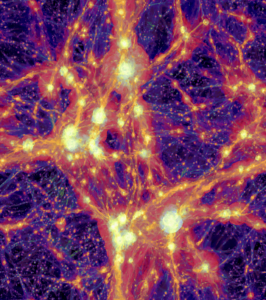The next decade promises to be a golden epoch for radio astronomy as several truly revolutionary instruments on the path to the Square Kilometre Array (SKA) are deployed. SKA pathfinders such as the mid-frequency ASKAP or MeerKAT telescopes and low-frequency MWA and LOFAR present opportunities for ground-breaking science. ASKAP’s innovative phased-array feed technology allows for a wide field of view and the ability to survey the whole sky to impressive depths with unparalleled speed. Its Evolutionary Map of the Universe (EMU) survey, with complimentary Polarisation Sky Survey of the Universe’s Magnetism (POSSUM), will observe the southern sky near 1 GHz to a depth 30 times better than any existing large-area survey in continuum and polarisation, with the MWA’s GLEAMX survey providing similar sky coverage of the whole southern sky at low frequencies.
The science spans a vast range of astrophysics and cosmology, probing Milky Way-like galaxies up to z = 1, powerful starbursts to greater redshifts (z ∼ 2 − 3), AGNs to the edge of the Universe, and continuing to discover new classes of object. The combination of these multiple surveys, along with new optical and X-ray surveys, will allow us to answer questions on galaxy formation and evolution, and structure formation.
We know the Universe has structure to it, large clusters of galaxies connected along filaments making the cosmic web. Magnetic fields also permeate this web in the space between the galaxies. These magnetic fields should give off emission at radio wavelengths. But even though magnetism is a fundamental force of nature, much remains unknown about its role and significance in the formation of the large scale structure of the Universe. Where did these magnetic fields come from or what is their origin in the early Universe? How have they changed over time ? What role do they play in galaxy evolution ? Similar gaps remain when looking at the magnetic fields the galaxies themselves such as what is the role of the magnetic fields in star formation or quenching, their role in the galaxy’s morphology and what can the galaxy’s magnetic fields tell us about the evolution of the galaxies.
Possible project ideas and potential supervisors are below:
- Resolved studies of star-forming galaxies (Ivy Wong & Tessa Vernstrom)
- Detecting and characterising the faint radio shockwaves in the cosmic web (Tessa Vernstrom)
- Radio galaxy classification with machine learning & citizen science (Ivy Wong & Tessa Vernstrom)
- Properties of Radio galaxies in cosmic web filaments (Tessa Vernstrom)
- Diffuse radio emission in clusters of galaxies (Tessa Vernstrom)
- Radio galaxies and their polarisation properties in the early Universe (Tessa Vernstrom)
- The Mystery of the Cosmic Radio Background (Tessa Vernstrom)

The simulated magnetic fields and synchrotron emission of the cosmic web. The diffuse radio emission remains challenging to detect while being important for theories of the growth of large-scale structure in the Universe. Fig credit: Franco Vazza.
Some additional links on related works:
- https://theconversation.com/the-largest-structures-in-the-universe-are-still-glowing-with-the-shock-of-their-creation-199785
- https://theconversation.com/we-found-some-strange-radio-sources-in-a-distant-galaxy-cluster-theyre-making-us-rethink-what-we-thought-we-knew-187631
- https://theconversation.com/dancing-ghosts-a-new-deeper-scan-of-the-sky-throws-up-surprises-for-astronomers-165239
- https://theconversation.com/how-citizen-scientists-discovered-a-giant-cluster-of-galaxies-59373